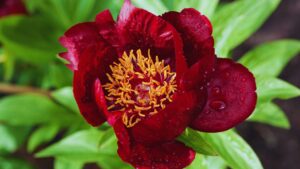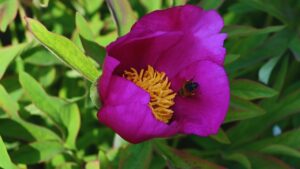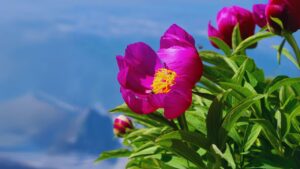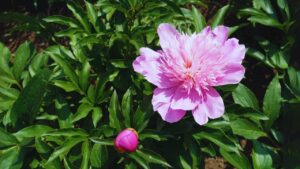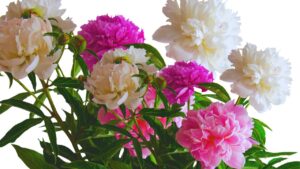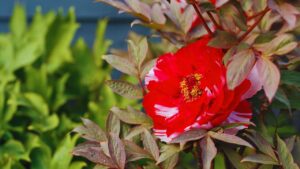Introduction
The Paeonia broteroi exists as a delicate species of peony that lives naturally in the Iberian Peninsula. Paeonia broteroi attracts interest from botanists because of its incredible blooms and distinctive plant behaviors and horticulturists and garden enthusiasts invoke the same level of admiration. Unlike more common types this rare peony maintains importance in its natural environment while contributing genetic worth to Paeonia taxonomy.
Origin and Distribution
Native Habitat
Paeonia broteroi is completely determined in Spain and Portugal, thriving surely in rocky slopes, woodlands, and open meadows. The plant flourishes in areas with a Mediterranean climate, in which it benefits from slight winters and heat summers. Well-tired soil is important for its survival, as immoderate moisture can result in root rot, making rocky and sandy terrains excellent for its boom.
This species prefers elevations that provide moderate rainfall without excessive humidity. Paeonia broteroi frequently grows along distinctive drought-tolerant plants, adapting to seasonal changes with resilience. It can resist occasional dry spells, making the most of the herbal drainage of its local habitat. The presence of this species in several terrains showcases its ability to conform to critical ecological settings within its geographic range.
Climate Adaptation
Paeonia broteroi has an outstanding model to the Mediterranean climate, thriving in areas in which summers are dry and winters stay slight. This variation lets it stay to inform the story for extended periods without water even as though preserving its structural integrity. Its deep root tool permits it to soak up moisture from decreased soil layers, ensuring survival eventually of seasonal droughts generally determined in its neighborhood areas.
Due to its robust drought tolerance, Paeonia broteroi is a splendid preference for sustainable gardening in dry climates. It may be grown in xeriscapes, where water conservation is a concern. Unlike many decorative plant life that require commonplace irrigation, this species can flourish with minimal care, making it a realistic desire for inexperienced landscapes designed to lessen water utilization.
Botanical Characteristics
Growth and Structure
Paeonia broteroi is an herbaceous perennial that reaches a pinnacle of approximately 60 cm at complete maturity. The plant produces lush, divided leaves that continue to be deep green at some stage inside the developing season, including visible appeal to gardens. Its stems are strong but bendy, allowing it to face up to slight winds even while maintaining its upright posture. The plant’s compact growth makes it appropriate for garden beds and wild landscapes.
Its foliage gives a putting evaluation to its colourful plants, contributing to its ornamental cost. The divided leaves create a sensitive texture that enhances the plant’s commonplace aesthetic enchantment. Since it grows in a clumping dependancy, its offices work dense patches of greenery that offer an appealing backdrop for its seasonal blooms, making it a fave among gardeners and panorama designers.
Flower Appearance
One of the most placing features of Paeonia broteroi is its wonderful floral show. The plant produces massive, cup-shaped plant life in a bright color of crimson, making it a showstopper in any garden. Each bloom has sensitive, overlapping petals that create a gentle, fashionable look. At the middle, golden stamens evaluate extraordinarily toward the red records, enhancing the flower’s common appeal.
The plant life is not most effective visually lovely however, additionally enchantment to pollinators which includes bees and butterflies, contributing to biodiversity. Their awesome duration and ambitious color lead them to without difficulty great in garden settings. Due to their attractive form, these flora are often used for ornamental abilities in cultivated landscapes, including a touch of vibrancy to herbal and designed environments.
Seasonal Growth Cycle
Paeonia broteroi follows a nicely-defined seasonal growth cycle, beginning with the emergence of glowing shoots in early spring. As temperatures rise, the plant reminisces speedy vegetative increase, developing its signature inexperienced foliage. By past due spring, flower buds begin forming, getting geared up for a putting floral display that usually lasts for numerous weeks. During this stage, best situations alongside moderate watering and good enough sunlight hours enhance its flowering ordinary overall performance.
As summer season transitions into autumn, the plant enters a dormancy phase, where its foliage starts off and evolves to die again. This dormancy lets in Paeonia broteroi to maintain power for the following developing season. The cycle repeats the following year, with the plant developing more potent if nicely maintained. Gardeners can use this herbal rhythm to devise care sporting events, making sure the plant remains healthful and energetic twelve months after three hundred and sixty five days.
Ideal Soil and Sunlight Conditions
Paeonia broteroi flourishes in nicely-worn-out soil with a slightly basic to impartial pH, making loamy or sandy soils high-quality for its boom. Excess moisture can bring about root rot, so it’s important to plant it in regions in which water drains efficiently. Adding herbal recollect can decorate soil shape and offer important nutrients, selling extra healthy root improvement and common plant electricity.
For satisfactory flowering and increase, Paeonia broteroi requires complete to partial sunlight hours publicity. It ought to gather at least six hours of direct or filtered sunlight hours each day to inspire right blooming. While it can tolerate some color, too much can lessen flower manufacturing and weaken its form. Selecting a sunny location ensures the plant continues its strong shape and produces abundant blooms at a few stages inside the growing season.
Watering and Fertilization
Paeonia broteroi is specially tolerant of dry conditions however blessings from occasional deep watering in the course of extended droughts. Instead of common shallow watering, which promotes prone roots, thorough irrigation at prolonged intervals encourages robust root boom. This technique ensures the plant remains resilient in warm, dry situations without turning into depending on excessive moisture.
Applying a balanced herbal fertilizer in early spring lets in assist healthy foliage and massive flowering. A slow-launch fertilizer or compost-based amendment offers crucial vitamins over time, selling constant boom. Over-fertilization wants to be averted, as immoderate nutrients can result in immoderate leafy growth on the fee of blooms. Proper feeding enhances the plant’s durability and flowering potential.
Pruning and Maintenance
Paeonia broteroi requires minimum pruning, making it a clean-to-preserve lawn plant. The number one maintenance project includes deadheading spent vegetation to encourage non-forestall blooming and save you self-seeding. Removing wilted blooms enhances the plant’s aesthetic enchantment and directs electricity in the direction of root and foliage improvement rather than seed manufacturing.
To save you from the growing season, gardeners want to lessen back the plant’s foliage to floor level. This workout saves you illness and keeps plant power for the subsequent growing cycle. Proper pruning in autumn minimizes pest infestations and ensures healthful regrowth within the following spring, retaining the plant in greatest situation for future blooms.
Planting Steps for Paeonia broteroi
1. Choosing the Right Location
Selecting the right region is the first step in efficiently planting Paeonia broteroi. This wild peony prospers in properly-tired soils with adequate daytime exposure. It prefers full sun to partial color, requiring at least six hours of direct daylight hours day by day. Avoid planting in low-mendacity regions in which water has a tendency to accumulate, as greater moisture can motive root rot and fungal ailments.
Additionally, pick out a domain with true air waft to reduce the hazard of illnesses like powdery mold. Paeonia broteroi want to not be planted near massive wood or shrubs that compete for nutrients and water. A barely sloped place or raised lawn bed is a tremendous choice, because it improves drainage and prevents water from settling at some point of the roots.
2. Preparing the Soil
Proper soil schooling is vital for the wholesome boom of Paeonia broteroi. This plant thrives in slightly alkaline to unbiased soil, with a pH amongst 6.Five and 7.Five. Conducting a soil test earlier than planting lets in determine whether or not or not amendments are desired. If the soil is absolutely too acidic, including lawn lime can increase the pH, at the same time as sulfur can decrease overly alkaline soils.
Loosen the soil to a depth of 12 to 18 inches to encourage deep root increase. Mixing in organic count number, which includes compost, well-rotted manure, or leaf mould, improves soil shape and nutrient availability. If the soil has awful drainage, including coarse sand or perlite can help prevent more moisture retention. Avoid using heavy clay soils, as they could suffocate the roots and keep away from plant development.
3. Planting the Paeonia broteroi
Once the net website online and soil are prepared, it’s time to plant Paeonia broteroi. If planting bare-root peonies, dig hollow instances the width of the premise gadget and deep enough to deal with the roots without bending them. Position the foundation crown no more than 1 to 2 inches below the soil surface. Planting too deeply can postpone flowering, while planting too shallowly can also expose the roots to harsh climate conditions.
For box-grown flora, cautiously eliminate them from the pot and loosen the roots in advance rather than placing them within the hollow. Fill the hollow with soil at the same time as lightly pressing it throughout the roots to put off the air wallet. Water very well after planting to assist settle the soil and encourage robust root recognition. Spacing is also vital—maintain as a minimum 24 to 36 inches among flora to allow for proper air movement and growth.
4. Watering and Mulching
Watering is essential, particularly for the duration of the early growth degrees of Paeonia broteroi. Newly planted peonies ought to be watered deeply more than one instance each week, counting on weather situations. The motive is to keep the soil constantly wet but not waterlogged. Once set up, the ones flora end up pretty drought-tolerant and require a lot less not unusual watering, besides during extended dry spells.
Applying a 2 to 3-inch layer of organic mulch throughout the lowest part of the plant enables it to hold soil moisture, modify temperature, and suppress weeds. Suitable mulching materials include shredded bark, straw, or leaf litter. However, avoid piling mulch straight away in the direction of the crown of the plant, as excessive moisture buildup can result in fungal infections and rot.
5. Providing Proper Care After Planting
After planting, proper care ensures the prolonged-term health and energy of Paeonia broteroi. In early spring, observe a balanced fertilizer to inspire strong boom and flower manufacturing. A 2d software program of low-nitrogen fertilizer after blooming allows toughen the roots and prepares the plant for dormancy. Avoid excessive nitrogen, as it can purpose lush foliage on the rate of blooms.
Deadheading spent flora no longer handiest complements the plant’s appearance but also prevents useless power consumption. At the surrender of the growing season, lessen once more the foliage to floor level to prevent contamination unfold and encourage healthy regrowth within the following three hundred and sixty five days.
If winter temperatures drop extensively, which include a protective mulch layer can assist insulate the roots from frost damage. With the right care, Paeonia broteroi will thrive and maintain to supply cute blooms for many years.
Propagation Methods
Growing from Seeds
Paeonia broteroi may be propagated from seeds, however germination is regularly gradual and unpredictable. Seeds require cold stratification to interrupt dormancy, mimicking the natural winter conditions they’ll revel in in the wild. Without this method, germination rates live low, and seedlings can also take years to mature into flowering vegetation.
Once germinated, seedlings want to be nurtured in a controlled surroundings before being transplanted outside. They want nicely-drained soil and adequate moisture at some degree inside the early tiers of development. While seed propagation calls for staying energy, it allows for genetic variety amongst new vegetation, making it a feasible alternative for those in search of to domesticate specific variations of the species.
Division of Roots
A greater dependable propagation approach includes the branch of mature root clumps. This technique is greatly completed in early autumn while the plant is moving into dormancy. Each divided section needs to include feasible buds and a healthy root device to make sure an achievement sets up order. Well-prepared divisions get higher quickly and start a new boom by the subsequent spring.
Dividing flora allows them to keep their electricity and prevents overcrowding, bearing in mind more healthy growth in lawn settings. The separated sections need to be planted in properly-organized soil with good enough spacing to sell proper airflow and reduce opposition for nutrients. This method gives a quicker manner to boom a Paeonia broteroi series with minimum chance of failure.
Ecological and Medicinal Importance
Role in Ecosystem
Paeonia broteroi plays a crucial function in enhancing biodiversity through imparting nectar and pollen to several pollinators, which incorporates butterflies, bees, and different useful insects. As a wild species, it allows neighborhood ecosystems with the beneficial useful resource of retaining these pollinators, which might be crucial for the replication of many plant species. Its presence in natural habitats strengthens ecological interactions, selling the health and balance of surrounding plants and fauna.
Beyond pollination, Paeonia broteroi additionally contributes to soil safety through its root machine. By stabilizing the soil in its local surroundings, it prevents erosion, in particular in rocky and sloped terrains. This feature is especially crucial in Mediterranean areas, in which dry situations and free soils make landscapes vulnerable to degradation. The plant’s resilience guarantees that it continues to assist its surroundings balance with minimal human intervention.
Traditional Medicinal Uses
Historically, Paeonia broteroi has been applied in traditional treatment for its reputed anti-inflammatory and pain-relieving houses. Healers and herbalists have blanketed extracts from its roots and petals to treat illnesses which encompass muscle pain, joint stiffness, and inflammatory situations. Its potential medicinal blessings had been passed down through generations, forming part of herbal restoration practices in regions wherein the plant is nearby.
Despite its historic use, medical research on Paeonia broteroi remains confined. Unlike different peony species that have been significantly studied for medicinal applications, this species has obtained loads less interest in cutting-edge-day-day pharmacology. However, researchers hold to discover its chemical composition and recuperation ability, aiming to find new medicinal homes that could contribute to opportunity remedies for numerous fitness conditions.
Read also: Moutan Peony: The King of Peonies
Conservation and Sustainability
Threats to Wild Populations
The survival of Paeonia broteroi in its herbal habitat faces a couple of threats, frequently due to habitat destruction, climate change, and overharvesting. Urbanization and agricultural enlargement have caused a loss of untamed-growing areas, lowering the supply of suitable environments for the species. Additionally, moving weather styles, inclusive of prolonged droughts and growing temperatures, affect its increase and reproductive fulfillment.
Unregulated collection of Paeonia broteroi for ornamental and medicinal use in addition endangers wild populations. Overharvesting disrupts herbal regeneration cycles, making it difficult for the species to maintain wholesome population degrees. Conservation efforts are essential to defend those neighborhood peonies, with techniques focused on habitat safety, responsible cultivation, and the hooked up order of moral harvesting practices to save you in addition to population decline.
Preservation Strategies
Efforts to conserve Paeonia broteroi incorporate a mixture of in-situ and ex-situ strategies. Botanical gardens play a large characteristic in retaining this species by means of the use of cultivating it in managed environments, wherein it can thrive without the pressures of habitat destruction. These gardens also function as study centers, offering precious insights into the plant’s growth behavior and genetic diversity.
Other conservation measures embody seed banking and habitat restoration tasks. Seed banks preserve feasible seeds for destiny propagation, ensuring the species may be reintroduced into the wild if important. Meanwhile, habitat restoration obligations rely on replanting and protective neighborhood landscapes to inspire herbal regeneration. Sustainable gardening techniques, consisting of water-green landscaping and natural soil manipulation, additionally assist keep the species in cultivation without negative wild populations.
Read also: Common Peony: A Classic Beauty in Gardens
Companion Plants
Best Companion Plants
The cultivation of Paeonia broteroi advantages from cautiously deciding on accomplice plant life that decorate its visible attraction on equal time as supporting a balanced lawn environment. Some satisfactory companion flora include:
Lavender (Lavandula spp.): This fragrant herb now not simplest enhances Paeonia broteroi with its crimson flora but moreover repels pests, growing a greater resilient garden environment.
Salvia (Salvia spp.): The tall, spiky blooms of salvia upload top version to lawn beds even as attracting pollinators that still advantage Paeonia broteroi.
Foxglove (Digitalis spp.): With its setting, bell-typical plant life, foxglove affords a contrasting coloration scheme and vertical hobby, pairing well with the huge blooms of Paeonia broteroi.
Hosta (Hosta spp.): In part shaded gardens, hostas characteristic and first rate ground cover, providing lush inexperienced foliage that enhances the peony’s form without competing for property.
Alliums (Allium spp.): These globe-fashioned plants now not handiest upload a totally unique seen element however moreover assist deter pests that would damage Paeonia broteroi.
Plants to Avoid
While some plants beautify the increase and aesthetics of Paeonia broteroi, others can avoid its development. Aggressive floor covers and deep-rooted shrubs want to be averted, as they compete for nutrients and vicinity.
Mint (Mentha spp.): Although beneficial for its perfume and culinary packages, mint spreads aggressively and may overpower peonies, limiting their boom.
Certain Bamboo Species: Some bamboo kinds grow full-size root structures that compete with Paeonia broteroi for water and nutrients, making them incorrect companions.
By choosing well right accomplice vegetation and keeping off invasive species, gardeners can cultivate a harmonious and thriving panorama that highlights the beauty of Paeonia broteroi at the same time as supporting its increase and durability.
Read also: Paeonia mairei: A Rare and Elegant Peony Species
Pests and Diseases
Common Pests
Paeonia broteroi demonstrates ok pest resistance however some times of aphid and spider mite and thrip infestations had been stated. The tiny bugs injure leaves collectively with flower buds once they draw plant fluid via their bodies. Infestations of plant pests can be controlled by way of using insecticidal cleaning soap and introducing the useful ladybug populace.
Fungal Diseases
The plant Paeonia broteroi researches vulnerability to 3 most crucial fungal diseases which includes botrytis blight collectively with powdery mildew and root rot. Plant stems and flower quantities expand grey mould because of Botrytis blight infections even as fungus-delivered about powdery mildew workplace work as a white coating on foliage. Keeping the air flowing well and watering the flora from below can help save you fungal illnesses and affected elements need to be removed straight away.
Preventative Measures
Olga Garden suffers from sickness dangers which encompass mulching the plant base effectively and spacing well and regularly clearing particles from its vicinity lets in to decrease. The remaining opportunity is to apply fungicidal spray as a protecting degree.
Conclusion
The remarkable flower Paeonia broteroi stands out as a fascinating and uncommon peony species which demands wider appreciation of its elegant appearance along with its strong resistance and environmental value. Paeonia broteroi exists as a garden plant and as a natural wildflower that draws worldwide interest from plant lovers. Our knowledge of growth requirements and conservation needs enables us to work for protecting this important species’ survival through upcoming generations.
Read more: Wild Peony: A Natural Beauty in the Wild



